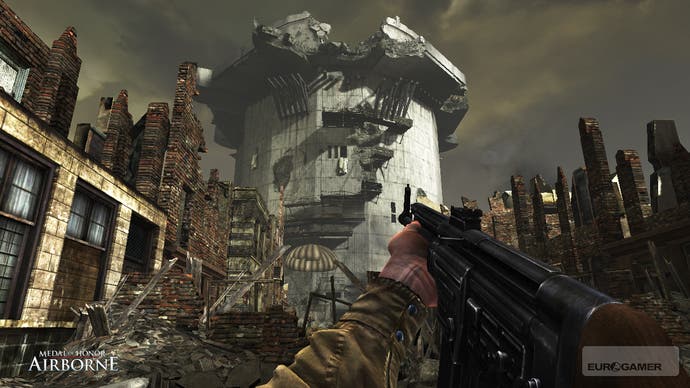Medal of Honor: Airborne
Up in the sky.
And underpinning the delightful sense of freedom, the excellent combat, and the buffed-up weapons system is a control system that has to rank as one of the best ever devised for a console FPS. Essentially borrowed wholesale from the long-forgotten European Assault, the so-called Ironsights system is easily the most flexible and intuitive method anyone's come up with, allowing the player to easily duck, lean and pop up from behind cover without resorting to complicated button combos. Simply holding down the left trigger enables your gun sights, and from there you can use the left stick to peek up, left or right from behind cover. Used when crouched, it's an exceptionally useful action to be able to perform in a game which demands that the player makes sensible use of any cover points you come across. And as well as being easy to pull off, the sensitivity is set perfectly, allowing you to lean out just as much as you need to - vital when you're sniping and need to nail that git right between the eyes.
If this is sounding improbably impressive, then the fact that the graphics engine does the business only adds to your overall appreciation that EA has really pulled out all the stops to get the Medal of Honor series back on top of the WWII pile. The sense of awe as you dive from a plane is certainly something that never gets dull, with jaw-dropping detail levels, flawless draw distance and none of the horrible pop-up glitchiness that used to jar the immersiveness in past WWII efforts. We're used to cinematic chaos in WWII games, but this definitely cranks it up to another level, with so much going on you'll struggle to take it all in.

Up close, the general architectural craft and ambition on display is so far beyond the kind of limiting rubbish we're used to that you want to shake the level designers by the hand for finally taking the shackles off. While there are, of course, still limits to what you can do and where you can go, it's now big enough, and sufficiently multi-layered to give such an incredible depth to each of the game's six campaigns that you don't need it to be any bigger. By the time you feel like you've seen everything there is to see, you're whisked away somewhere else, and have fun exploring all over again. The best feeling, though, is piecing together a map of your environment in your head as you go along - that simply never happened before in WWII games, but now there's this real sense of place when playing Airborne. It's the same feeling of playing multiplayer in an intricately constructed map, only with the focus and immersion that comes with a good single-player campaign. The vistas you look out upon don't hurt, either, giving the impression of proper geometry, rather than some cheap bitmapped cop-out. It's a title with a lot of love lavished on it. Being extra critical, the environments still lack that extra degree of destructibility that we call long for, but that's arguably one for the next generation. Let's not get too picky.

Having said all that, Airborne's not without its own niggles. Chief of these is the save/checkpointing system, which demands that you've completed one of the objectives before it will save your progress. What inevitably happens is that you'll often fail in a given task and find yourself not only back in the aircraft, but tasked with taking down the dozens of Germans you just painstakingly picked off. For the first half of the game, the challenge is sufficiently easy for it not to matter, but by the time you hit the bridge on Operation Market Garden, or slog through the brutally tough Operation Varsity, you'll scream at EA LA's studio leads for allowing such unnecessary frustration to spoil what was shaping up to be an almost flawless experience. At the very least, the game should be capable of knowing which enemies you just took out and allow you to carry on - but having spent 15 minutes taking out snipers, only to find yourself with no choice but to do it all again...well, it's sofa-punching stuff of the highest order.
What's important, though, is to not get bogged down in the detail too much. It's a game that, when played under pressure, can be a real pain, but taken at your leisure is one to savour. With an excellent mission-rating system in place, it's also one of the few games that gives you an incentive to go back and do better. If only more shooters had such in-built replayability. With 12-player online team deathmatch and capture the flag thrown in there for good measure (that we couldn't test because, well, no-one was online yet!) across all six maps, there's even more reason to cast off your Medal of Honor prejudice and enjoy the best World War II game to date.

